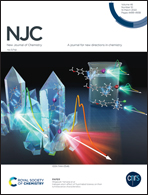Targeted pH/redox dual-responsive nanoparticles for cancer chemotherapy combined with photodynamic/photothermal therapy†
Abstract
The application of intelligent responsive nanoparticles in combination therapy has become an emerging issue in cancer therapeutics. In this work, we have constructed a dual-responsive targeted nanoparticle for multi-modal combination therapy (ICG/DOX@HMSNs-SS-N![[double bond, length as m-dash]](https://www.rsc.org/images/entities/char_e001.gif) C-HA or simplified to ID@HMSNs-SNH). The chemotherapeutic doxorubicin (DOX) and the photosensitizer indocyanine green (ICG) are loaded into hollow mesoporous silica nanoparticles (HMSNs) by physical embedment. These HMSNs are coated with oxidized hyaluronic acid (OHA) by a pH-sensitive Schiff base bond and a redox-sensitive disulfide bond to prevent the drugs from leaking. They not only showed intelligent controlled drug release properties, but also can fully integrate photothermal/photodynamic therapy (PTT/PDT) to develop synergistic anti-tumor efficacy as confirmed by in vitro evaluations. Cell uptake experiments proved that they could selectively target tumor cells overexpressing CD44 receptors, thus reducing their uptake by normal cells. Moreover, cytotoxicity experiments displayed their satisfactory anti-tumor (HepG2) effect with an IC50 value of 0.09 μg mL−1. In conclusion, the obtained ID@HMSNs-SNH concurrently releases drugs that respond to a slightly acidic and reducing tumor microenvironment (TME), displaying great performances of chemotherapy with PTT/PDT in vitro for tumor ablation.
C-HA or simplified to ID@HMSNs-SNH). The chemotherapeutic doxorubicin (DOX) and the photosensitizer indocyanine green (ICG) are loaded into hollow mesoporous silica nanoparticles (HMSNs) by physical embedment. These HMSNs are coated with oxidized hyaluronic acid (OHA) by a pH-sensitive Schiff base bond and a redox-sensitive disulfide bond to prevent the drugs from leaking. They not only showed intelligent controlled drug release properties, but also can fully integrate photothermal/photodynamic therapy (PTT/PDT) to develop synergistic anti-tumor efficacy as confirmed by in vitro evaluations. Cell uptake experiments proved that they could selectively target tumor cells overexpressing CD44 receptors, thus reducing their uptake by normal cells. Moreover, cytotoxicity experiments displayed their satisfactory anti-tumor (HepG2) effect with an IC50 value of 0.09 μg mL−1. In conclusion, the obtained ID@HMSNs-SNH concurrently releases drugs that respond to a slightly acidic and reducing tumor microenvironment (TME), displaying great performances of chemotherapy with PTT/PDT in vitro for tumor ablation.



 Please wait while we load your content...
Please wait while we load your content...